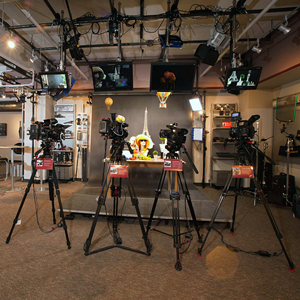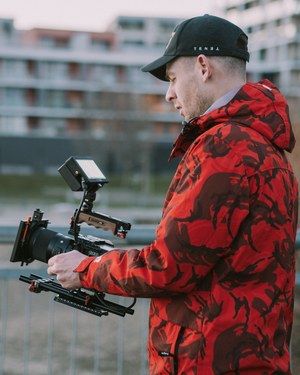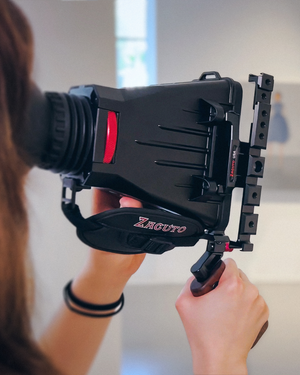
8 Things to Consider When Choosing a Camera
So you got the job - the Director loves you, and the Producer can tolerate you. Nice! Now what?
You have to choose a camera.
If you own the right one, then the answer is obvious. And maybe that’s why the producers can tolerate you. But if not… how do you go about choosing a camera?
I have never owned equipment, because I haven’t wanted the trouble of maintenance, storage, and obsolescence. And because that same producer, that’s able to tolerate me, always wants me to throw the camera in for free. It might be arrogant but I don’t really want to be hired because I have free equipment. But I guess it works well for those who are owner/operators.
Half the time when I shoot a movie these days, I don’t have a choice of which camera to use. The producer tells me, “I just bought a couple of REDs, so that’s what we are going to shoot on.”
But here are my criteria, in order, of what I look at in choosing from the plethora of cameras available.
“Frankly I don’t give a damn…” which camera I shoot on these days. With very few exceptions they are all more than good enough to make a feature film on.
So, to start, as the politicians say: “It’s the glass, stupid!”
 That alone will cut down your choices, though many cameras with EF mounts will take a PL conversion adapter. But it certainly eliminates any Camcorders.
It may be that you want a lot of different lenses to shoot your picture, and you want the most number of lenses you can get for the money. In which case you will probably select EF lenses.
I haven’t heard of many people using an EF adaptor on a PL mount camera, but I’m sure it’s been done.
You may want to shoot your movie entirely with a couple of zoom lenses, or “variable primes” as the better quality ones like to be known. If you do, and you like to use a zoom motor or a studio follow focus you will need PL mount lenses.
That alone will cut down your choices, though many cameras with EF mounts will take a PL conversion adapter. But it certainly eliminates any Camcorders.
It may be that you want a lot of different lenses to shoot your picture, and you want the most number of lenses you can get for the money. In which case you will probably select EF lenses.
I haven’t heard of many people using an EF adaptor on a PL mount camera, but I’m sure it’s been done.
You may want to shoot your movie entirely with a couple of zoom lenses, or “variable primes” as the better quality ones like to be known. If you do, and you like to use a zoom motor or a studio follow focus you will need PL mount lenses.
 It used to be that RED had a problematic workflow requiring an expensive piece of hardware just to transcode the footage for editing. But that’s now a thing of the past with several editorial softwares being able to cope with native R3D files.
It might be that you choose a camera which has only a RAW workflow. One camera I tested recently had a transcode engine, which required purchasing a high-end color-correction program. There was a free software transcoder that you could download, but it took me four days to transcode two hours of footage. There was no way to queue the files, so every couple of hours I had to set a new file to process. A nightmare you wouldn’t want the production to be stuck with, let alone the editor. So beware of your workflow.
It used to be that RED had a problematic workflow requiring an expensive piece of hardware just to transcode the footage for editing. But that’s now a thing of the past with several editorial softwares being able to cope with native R3D files.
It might be that you choose a camera which has only a RAW workflow. One camera I tested recently had a transcode engine, which required purchasing a high-end color-correction program. There was a free software transcoder that you could download, but it took me four days to transcode two hours of footage. There was no way to queue the files, so every couple of hours I had to set a new file to process. A nightmare you wouldn’t want the production to be stuck with, let alone the editor. So beware of your workflow.
 People will tell you that 2K is still the de facto standard for theatrical distribution… and it may well be… but for how much longer?
People will tell you that 2K is still the de facto standard for theatrical distribution… and it may well be… but for how much longer?
 Some cameras shoot raw files and ProRez files simultaneously. Some features I’ve shot only wanted to use the ProRez files because of the cost of hard drives and data management through out the process.
Shooting some RAW codecs take up an incredible amount of data space. The Sony F65 camera comes with a rolling cart full of drives, processors and decks just for managing the massive amount of data on-set - beautiful pictures, but a lot of infrastructure.
Some cameras shoot raw files and ProRez files simultaneously. Some features I’ve shot only wanted to use the ProRez files because of the cost of hard drives and data management through out the process.
Shooting some RAW codecs take up an incredible amount of data space. The Sony F65 camera comes with a rolling cart full of drives, processors and decks just for managing the massive amount of data on-set - beautiful pictures, but a lot of infrastructure.
 In order to shoot Hi-Speed (slow-motion) images, some cameras will change the amount of the sensor that they utilize. I admit I get totally confused about how wide an image is going to be with any given focal length lens. I’ve given up trying. I just put up a 50mm and say a bit wider or a bit longer.
In order to shoot Hi-Speed (slow-motion) images, some cameras will change the amount of the sensor that they utilize. I admit I get totally confused about how wide an image is going to be with any given focal length lens. I’ve given up trying. I just put up a 50mm and say a bit wider or a bit longer.
 This is important because, when you pan the camera fast on a tall building with a non-global shutter the building seems like it is leaning over at an angle. Or like what you see in car footage shot with a GoPro camera. It makes the whole world look like it’s made of Jello.
This is important because, when you pan the camera fast on a tall building with a non-global shutter the building seems like it is leaning over at an angle. Or like what you see in car footage shot with a GoPro camera. It makes the whole world look like it’s made of Jello.

 Rent your next camera from Zacuto Rentals!
Rent your next camera from Zacuto Rentals!
1. THE GLASS
The most important thing to me when choosing a camera is what lenses I want to use. And incidentally, they will probably cost more than whatever camera I rent. Lenses will have more of an influence on the look of your picture than your camera. So, maybe you want to use Hawk uncoated anamorphic lenses, which have PL mounts. So you will need a camera with a PL mount. That alone will cut down your choices, though many cameras with EF mounts will take a PL conversion adapter. But it certainly eliminates any Camcorders.
It may be that you want a lot of different lenses to shoot your picture, and you want the most number of lenses you can get for the money. In which case you will probably select EF lenses.
I haven’t heard of many people using an EF adaptor on a PL mount camera, but I’m sure it’s been done.
You may want to shoot your movie entirely with a couple of zoom lenses, or “variable primes” as the better quality ones like to be known. If you do, and you like to use a zoom motor or a studio follow focus you will need PL mount lenses.
That alone will cut down your choices, though many cameras with EF mounts will take a PL conversion adapter. But it certainly eliminates any Camcorders.
It may be that you want a lot of different lenses to shoot your picture, and you want the most number of lenses you can get for the money. In which case you will probably select EF lenses.
I haven’t heard of many people using an EF adaptor on a PL mount camera, but I’m sure it’s been done.
You may want to shoot your movie entirely with a couple of zoom lenses, or “variable primes” as the better quality ones like to be known. If you do, and you like to use a zoom motor or a studio follow focus you will need PL mount lenses.
2. WORKFLOW
My number two reason for choosing a camera is for its workflow, maybe because I do so much post work on the movies I shoot. But I think it’s selfish for a DP not to consider what happens to their footage after having all the fun of shooting it. It used to be that RED had a problematic workflow requiring an expensive piece of hardware just to transcode the footage for editing. But that’s now a thing of the past with several editorial softwares being able to cope with native R3D files.
It might be that you choose a camera which has only a RAW workflow. One camera I tested recently had a transcode engine, which required purchasing a high-end color-correction program. There was a free software transcoder that you could download, but it took me four days to transcode two hours of footage. There was no way to queue the files, so every couple of hours I had to set a new file to process. A nightmare you wouldn’t want the production to be stuck with, let alone the editor. So beware of your workflow.
It used to be that RED had a problematic workflow requiring an expensive piece of hardware just to transcode the footage for editing. But that’s now a thing of the past with several editorial softwares being able to cope with native R3D files.
It might be that you choose a camera which has only a RAW workflow. One camera I tested recently had a transcode engine, which required purchasing a high-end color-correction program. There was a free software transcoder that you could download, but it took me four days to transcode two hours of footage. There was no way to queue the files, so every couple of hours I had to set a new file to process. A nightmare you wouldn’t want the production to be stuck with, let alone the editor. So beware of your workflow.
3. RESOLUTION
Netflix now requires 4K or better image acquisition for new projects that they buy, and you wouldn’t want to want to exclude them as a company that might buy your project. In any case, a 4K master is a delivery requirement for most distribution companies now. You don’t want an HD or even 2K acquisition to be “blown up” to 4K. People will tell you that 2K is still the de facto standard for theatrical distribution… and it may well be… but for how much longer?
People will tell you that 2K is still the de facto standard for theatrical distribution… and it may well be… but for how much longer?
4. SPEED
The native Exposure Index of a camera is very important for shooting a feature film, especially if you are shooting a night picture in very low lighting. Perhaps you weren’t able to afford those expensive super-speed lenses? I suggest you shoot a test with the camera you intend to use, in the lighting that you will be using. This is because a lot of manufacturers make claims about their native ISO and their low noise features which, to put it politely… stretch the truth. Shoot your test footage, and take it through the color-correction process you are going to use for the project, to make sure you’re happy with the noise and data level.5. CODEC
The codec that a camera shoots is often proprietary. You need to make sure that the software your editor is using can handle these files, especially if the camera is new. Some cameras shoot raw files and ProRez files simultaneously. Some features I’ve shot only wanted to use the ProRez files because of the cost of hard drives and data management through out the process.
Shooting some RAW codecs take up an incredible amount of data space. The Sony F65 camera comes with a rolling cart full of drives, processors and decks just for managing the massive amount of data on-set - beautiful pictures, but a lot of infrastructure.
Some cameras shoot raw files and ProRez files simultaneously. Some features I’ve shot only wanted to use the ProRez files because of the cost of hard drives and data management through out the process.
Shooting some RAW codecs take up an incredible amount of data space. The Sony F65 camera comes with a rolling cart full of drives, processors and decks just for managing the massive amount of data on-set - beautiful pictures, but a lot of infrastructure.
6. SENSOR SIZE
I like 4 perf 35mm “Academy” sized sensors… mostly because when someone talks about an 18mm lens I know exactly what to expect, because I’m used to shooting 35mm film. I also like the amount of depth of field that I get using this size sensor. A lot of people like larger sensors, but for me the depth of field is a little too shallow and it’s tougher on the focus-puller. In order to shoot Hi-Speed (slow-motion) images, some cameras will change the amount of the sensor that they utilize. I admit I get totally confused about how wide an image is going to be with any given focal length lens. I’ve given up trying. I just put up a 50mm and say a bit wider or a bit longer.
In order to shoot Hi-Speed (slow-motion) images, some cameras will change the amount of the sensor that they utilize. I admit I get totally confused about how wide an image is going to be with any given focal length lens. I’ve given up trying. I just put up a 50mm and say a bit wider or a bit longer.
7. GLOBAL SHUTTER
The next most important feature for me is a “global shutter,” especially if I’m shooting an action picture. This is the feature where by all the photosites are activated simultaneously, as opposed to being scanned on line by line like an old TV signal. This is important because, when you pan the camera fast on a tall building with a non-global shutter the building seems like it is leaning over at an angle. Or like what you see in car footage shot with a GoPro camera. It makes the whole world look like it’s made of Jello.
This is important because, when you pan the camera fast on a tall building with a non-global shutter the building seems like it is leaning over at an angle. Or like what you see in car footage shot with a GoPro camera. It makes the whole world look like it’s made of Jello.
8. SIZE
Size does matter, especially if your picture is predominately hand held and shot in very tight quarters. These days, the lenses I use are usually heavier than the camera. But many of the new cameras that come out are way bigger than modern technology dictates. They usually say, “It’s the cooling. Makes them very reliable.” I’m afraid I no longer have use for the large Panaflex sized cameras. My ideal sized cameras are the Alexa Mini, the new mini Panasonic Cinema VariCam, and the Sony FS700. I’ve shot several films with DSLR cameras, but by the time you put a real lens on these cameras they are a bit fiddly and not too robust, especially when it comes to the mini HDMI plug. I hope this helps just a little when you are choosing a camera to work with from the myriad of choices! Happy shooting!
 Rent your next camera from Zacuto Rentals!
Rent your next camera from Zacuto Rentals!


Comments
Leave a comment